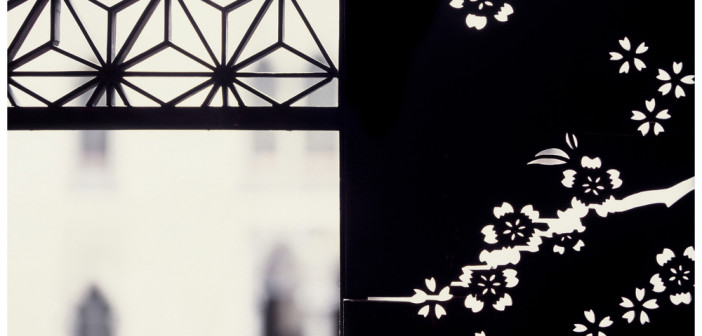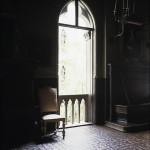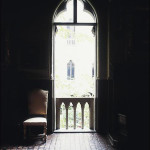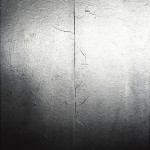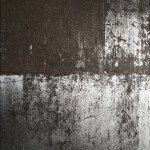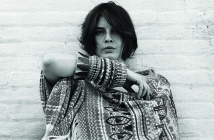Italian born and educated photographer, Luisa Lambri, uses a camera for what it was designed to do: capture light, shadow and the passage of time. It was an intelligent move on the part of curator Pieranna Cavalchini to invite Lambri during the Gardner's extensive expansion, when the institution was in a state of flux and all eyes were on the Renzo Piano building. Instead of residing at the Gardner for a prolonged time, Lambri came and went several times over the course of three years, observing and photographing the changing qualities of light at Fenway Court, reading through the diaries of its architect Willard T. Sears, and drafting endnotes of research for an artist's book. On view currently are five of those photographs and the published book. Come September 18th, the selection will rotate and the wall will welcome a third and final hanging of the work.
Cavalchini's essay, titled The Poetics of Light and Space, which concludes the book Luisa Lambri: Portrait, seems to refer in name to Gaston Bachelard's well-loved text on space, psychology and language, but the ties to Junichiro Tanazaki's In Praise of Shadows are far stronger. Sure, to him the Japanese toilet was the height of architectural perfection, but hear me out. Tanazaki mused on the texture of shadows – their gleam, sheen, pattern, tone and value – on the quality of a surface and its relationship to light. Tanazaki also mounted an argument against electric and artificial lighting – one which Lambri upholds in her process, for why light your subject when your subject is light itself? Given the limited intrusion of additional lighting in the Gardner Palace, the pairing of Luisa Lambri's aesthetic with Mrs. Jack's was appropriate.
To Lambri, photographing light and place is an act of self-portraiture. This is an interesting premise considering photographic portraits only rarely teach us more about their individual subject than how they look. Lambri's photographs of her self show us not a face but a human mind at work. They reveal how she responds to place, divulge what attracts her eye, reflect a mood, mindset or train of thought. Time and again, she's drawn to the glow of surfaces, to the aura of light around a window. The Gardner's remarkable art objects appear to hold no power over her and the closest they come to featuring in her portraits are through the frames left empty by the 1990 heist. It's got to be surreal for an Italian to find this medley of European art in Boston's reconstructed Venetian palazzo.
Portrait succeeds best when the real-world context for Lambri's image is less obvious. Two of the five photographs in the current iteration of the exhibition are of hallways in the Museum and say as little about Lambri as they add to the space represented. Leafing though the artist's book across from them I saw many more compelling images and felt short-changed by the selection. Furthermore, the photographs hang in a dimly lit salon-like cluster and take on the well-worn patina of the environment. While, formally, I understand the decision to exhibit this work in the Palace itself, and know the diktat Mrs. Gardner imposed on the presentation of her collection, this is a glorified vestibule and does no justice to the work. All the same, go, seek it out and, if you have fifty dollars to spare, buy the book.
- Luisa Lambri, Untitled (Isabella Stewart Gardner Museum #01, 2009) Courtesy of the artist and the Isabella Stewart Gardner Museum. www.gardnermuseum.org
- Luisa Lambri, Untitled (Isabella Stewart Gardner Museum, #15), 2008 Courtesy of the artist and Luhring Augustine Gallery, New York
- Luisa Lambri, Untitled (Isabella Stewart Gardner Museum, #16), 2008 Courtesy of the artist and Luhring Augustine Gallery, New York
- Luisa Lambri, Untitled (Isabella Stewart Gardner Museum, #11), 2009 Courtesy of the artist and Luhring Augustine Gallery, New York
- Luisa Lambri. Untitled (Isabella Stewart Gardner Museum, #08), 2009 Courtesy of the artist and Luhring Augustine Gallery, New York
- Luisa Lambri, Untitled (Isabella Stewart Gardner Museum, #05), 2009 Courtesy of the artist and Luhring Augustine Gallery, New York
- Luisa Lambri, Untitled (Isabella Stewart Gardner Museum, #24), 2008 Courtesy of the artist and Luhring Augustine Gallery, New York
Further information about Luisa Lambri at the Gardner
"Luisa Lambri: Portrait" is on view until October 15, 2012 at the Isabella Stewart Gardner Museum. www.gardnermuseum.org
All images are courtesy of the artist, Luisa Lambri, the Isabella Stewart Gardner Museum and galleries as stated

